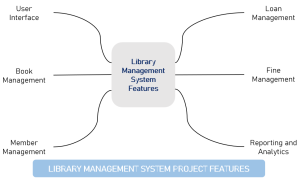Managing libraries, whether big or small, requires an organized and systematic approach to keeping track of books, members, and lending transactions. A Python-based Library Management System Project provides a comprehensive solution to efficiently manage library resources and enhance user experience. Here, we will delve into the process of creating a Library Management System Project in Python, exploring its key components, and design considerations, and providing a step-by-step implementation guide.
Key Components of a Library Management System Project
A well-rounded Library Management System Project encompasses several essential components:
- User Interface: The library staff should be able to efficiently manage book records, memberships, and lending operations through an intuitive and user-friendly interface.
- Book Management: This tool enables librarians to manage book records, including categorizing books, specifying authors, tracking copies, and managing ISBN numbers.
- Member Management: The system should allow users to register and manage their library membership, including the issuance and tracking of library cards. It should store member information such as names, contact details, and membership status.
- Loan Management: A system for tracking book loans should allow borrowing, returning, and renewal of books, generate due dates, and send reminders for overdue books.
- Fine Management: To manage late fees or fines incurred by members for overdue books. The system should accurately calculate and track fines, ensuring fair and transparent procedures.
- Reporting and Analytics: It’s crucial to have reporting and analytics features for library usage, popular books, and overdue items to make informed decisions.

Library Management System Project Features
Design Considerations
To ensure the success of your Library Management System Project, consider the following design considerations:
- Database: Efficient data management requires a well-structured database system, such as SQLite, MySQL, or PostgreSQL, to store book records, member data, loan history, and fine details.
- User Authentication: Implement strong user authentication mechanisms to protect library staff accounts, ensuring data security for sensitive user and book information.
- Scalability: Design a modular and extensible system to accommodate the future growth of the library’s collection and user base.
- Security: Prioritize security measures to protect against common vulnerabilities such as SQL injection, data breaches, and unauthorized access. Regular security audits are essential.
- User Experience: The focus must be on providing a user-friendly and intuitive interface. Library staff should be able to perform tasks efficiently without unnecessary complexity.
Step-by-Step Implementation
Now, let’s break down the implementation of a Library Management System Project in Python into key steps:
Setting Up the Environment:
- Install Python and select a web framework such as Flask or Django.
- Choose a suitable database system and set up the database schema.
- Install required libraries and packages using pip.
User Authentication:
- Implement user registration and login functionality.
- Utilize libraries like Flask-Login or Django Authentication for secure authentication.
Book Management:
- Create a user-friendly interface for librarians to add, update, and delete book records.
- Implement categorization, author management, and ISBN tracking features.
Member Management:
- Allow member registration and profile management.
- Generate and track library cards for members.
Loan Management:
- Develop features for borrowing, returning, and renewing books.
- Implement due date calculations and send reminders for overdue items.
Fine Management:
- Implement mechanisms for tracking and calculating fines.
- Offer librarians a user-friendly interface to manage fees.
Reporting and Analytics:
- Create dashboards and reports for administrators to gain insights into library usage and performance.
- Utilize Python libraries like Matplotlib and Pandas for data visualization.
Testing and Deployment:
- Thoroughly test the system to identify and resolve any bugs.
- Then, deploy the Library Management System Project on a public web server like Heroku, AWS, or DigitalOcean.
Creating a Library Management System Project in Python is a worthwhile pursuit that can provide significant advantages to libraries of any magnitude. By adhering to the suggested procedures, giving attention to design aspects, and ensuring user-friendly interfaces and strong security measures, you can create an effective and user-focused system.
Python’s versatility, combined with its web frameworks and database systems, makes it an ideal choice for building library management systems. A well-implemented project of this kind streamlines library operations, enhances member experiences, and provides valuable insights for administrators to make informed decisions. Whether you manage a university library, a public library, or a specialized collection, a Python-based Library Management System Project can help optimize your library’s operations and improve services for both library staff and members.
| You can get this Project Code. |








Leave a Comment